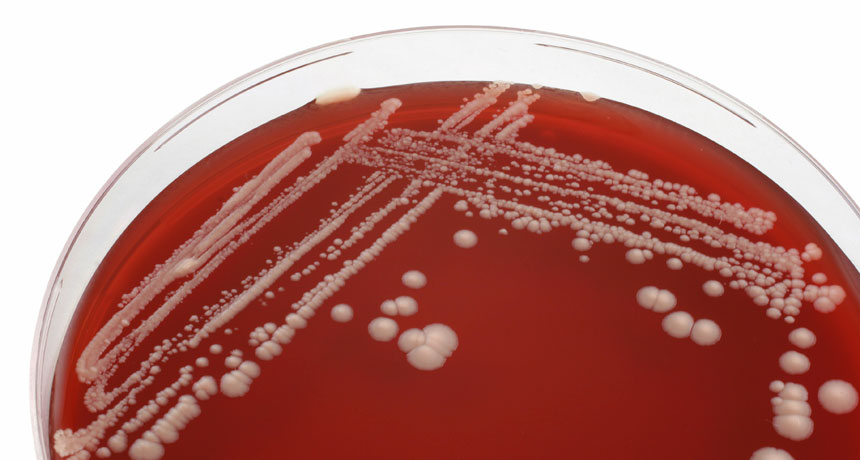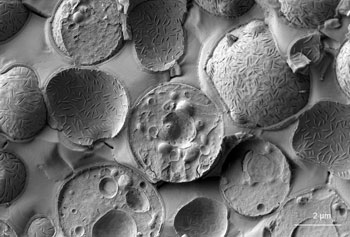Fattier yeast live long and prosper
Boosting a fat-storing molecule helped one-celled yeast live longer

To study yeast, scientists grow the single-celled creatures in Petri dishes.
Zirafek/iStockphoto
Many people frown at the thought of fattening up. But fats can be useful because they store energy. And new research finds that having extra fat might be good — for yeast, at least. Their “fat” cells can outlive lean ones.
For now, it’s unclear what these results mean for people — or even simpler organisms such as worms and flies.
Yeast consist of only a single cell. Still, the yeast genome, it’s complete package of genetic material, is surprisingly similar to ours. Certain genes that were first discovered in yeast have turned out to play similar roles in complex organisms, including people. Those genes are thought to have been conserved — preserved, largely unchanged — through millions of years of evolution. Some of those conserved genes even help regulate aging.
Aging wasn’t the original focus of the new study, says Min-Hao Kuo. He is a biologist at Michigan State University in East Lansing. His group had started off studying biofuels. These energy sources are designed to substitute for gas, coal and other fossil fuels that can contribute to climate change. Some biofuels come from plants. Others come from the type of green algae studied by Kuo’s team.
Algae contain a lot of fat. Some of it is stored in a molecule called TAG, short for triacylglycerol (Try-AAH-sil-GLIH-ser-al). Based on earlier studies, scientists knew there are several genes that control how much TAG a cell stores. Some genes drive the process of making TAG. Others trigger its breakdown. The researchers had hoped to create a “really fat” strain of alga by using genetic engineering to delete a breakdown gene, says Kuo. Chemical reactions could then release that stored energy to power vehicles, they figured.

Here’s what puzzled them: Yeast with modified DNA typically are not as hardy as the garden-variety lab strain. But in this case, the newly designed yeast seemed to grow better and live longer than the normal strain (with no genetic changes). The primary difference in this new yeast: It no longer had a TAG-breakdown gene.
This finding was so weird, Kuo recalls, that “we decided to look deeper.” His team examined a dozen more yeast strains. And again, those with more TAG outlived the strains with less of this fat.
To probe the link more carefully, the researchers went back to their initial, normal lab yeast. In some samples, they dialed down the amount of TAG in these cells by deleting genes for TAG production. Those cells became lean. They also didn’t live as long as normal yeast. On the flip side, yeast that were genetically tweaked to overproduce TAG enjoyed a longer life.
The researchers described their findings online February 23 in PLOS Genetics.
What should we make of this?
Kuo’s group notes that their TAG-longevity effects are not seen early on. That’s when yeast cells are dividing rapidly. The improved survival emerged only later — after cells had eaten up all of the available nutrients and stopped dividing (growing).
“The data look good,” says Matt Kaeberlein. However, he adds, it’s also not clear whether the results are relevant to people. Kaeberlein is a biologist who studies aging at the University of Washington in Seattle. If the Michigan team “could show the same thing in worms or flies,” he says, “that would make a stronger case that this mechanism might be relevant in mammals,” including people.
Kuo agrees that the findings are hard to interpret. “I’m not advocating for people to get fat,” he says. “But it’s also an oversimplification to think you have to get lean to live longer.”
Still, that’s been the conclusion of many experiments. Studies have shown that yeast, worms, flies, fish and rodents all tend to live longer when they consistently eat fewer calories. It’s been far less clear if long-term food restriction would make people live longer. It’s hard to do a study that long. And it would be unethical to start such a study with children. But there are people who practice calorie restriction in the hope that it will lengthen their lives.
Even in mice, the link between lifespan and calories may be more complicated than early tests had suggested.
The early experiments used strains of mice that were genetically identical. However, 5 years ago researchers published a study that analyzed calorie restriction in more than 40 strains of mice. These strains had inherited very different genes. And the impact of cutting calories led to lifespan effects that varied dramatically. In some strains, eating less lengthened lives. But for certain strains, dieting — cutting back on calories — shortened the rodents’ lifespan. And in some strains, restricting chow had no effect.
Such data suggest that something in the genes affects the link between calories and lifespan.
As it turns out, the mouse strains that survived better were those that tended to maintain much of their body fat as their calorie intake fell. And, though it’s a bit of a stretch, the mouse data could relate to the new findings in yeast, Kaeberlein says. Having more TAG when nutrients are in short supply, he says, might be good for yeast in the same way that being able to maintain enough fat allowed the dieting mice to live longer.
For now, the new findings are helping Kuo’s team understand the chemical reactions that control TAG production. And those insights, they’re happy to see, also should lead to better approaches for making biofuels.
Power Words
(for more about Power Words, click here)
algae (sing. alga) Single-celled organisms, once considered plants (they aren’t). As aquatic organisms, they grow in water. Like green plants, they depend on sunlight to make their food.
biochemistry A field that marries biology and chemistry to investigate the reactions that underpin how cells and organs function. People who work in this field are known as biochemists.
biofuels Fuels made from plant materials to provide energy, usually as a substitute for fossil fuels.
biology The study of living things. The scientists who study them are known as biologists.
calorie The amount of energy needed to raise the temperature of 1 gram of water by 1 degree Celsius. It is typically used as a measurement of the energy contained in some defined amount of food.
cell The smallest structural and functional unit of an organism. Typically too small to see with the naked eye, it consists of watery fluid surrounded by a membrane or wall. Animals are made of anywhere from thousands to trillions of cells, depending on their size. Some organisms, such as yeasts, molds, bacteria and some algae, are composed of only one cell.
chemical reaction A process that involves the rearrangement of the molecules or structure of a substance, as opposed to a change in physical form (as from a solid to a gas).
conserve To protect, as from loss or degradation.
diet (noun) The foods and liquids ingested by an animal to provide the nutrition it needs to grow and maintain health. (verb) To adopt a specific food-intake plan for the purpose of controlling body weight.
DNA (short for deoxyribonucleic acid) A long, double-stranded and spiral-shaped molecule inside most living cells that carries genetic instructions. It is built on a backbone of phosphorus, oxygen, and carbon atoms.In all living things, from plants and animals to microbes, these instructions tell cells which molecules to make.
enzymes Molecules made by living things to speed up chemical reactions.
evolution A process by which species undergo changes over time, usually through genetic variation and natural selection. These changes usually result in a new type of organism better suited for its environment than the earlier type. The newer type is not necessarily more “advanced,” just better adapted to the conditions in which it developed.
fat A natural oily or greasy substance occurring in animal bodies, especially when deposited as a layer under the skin or around certain organs. Fat’s primary role is as an energy reserve. Fat is also a vital nutrient, though it can be harmful to one’s health if consumed in excess amounts.
fossil fuels Any fuel — such as coal, petroleum (crude oil) or natural gas — that has developed in the Earth over millions of years from the decayed remains of bacteria, plant or animals.
fungus (plural: fungi) Any of a group of unicellular or multicellular, spore-producing organisms that feed on organic matter, both living and decaying. Molds, yeast and mushrooms are all types of fungi.
gene (adj. genetic) A segment of DNA that codes, or holds instructions, for producing a protein. Offspring inherit genes from their parents. Genes influence how an organism looks and behaves.
genetic engineering The direct manipulation of an organism’s genome. In this process, genes can be removed, disabled so that they no longer function, or added after being taken from other organisms. Genetic engineering can be used to create organisms that produce medicines, or crops that grow better under challenging conditions such as dry weather, hot temperatures or salty soils.
genome The complete set of genes or genetic material in a cell or an organism.
mammal A warm-blooded animal distinguished by the possession of hair or fur, the secretion of milk by females for feeding the young, and (typically) the bearing of live young.
mechanism The steps or process by which something happens or “works.” It may be the spring that pops something from one hole into another. It could be the squeezing of the heart muscle that pumps blood throughout the body. It could be the friction (with the road and air) that slows down the speed of a coasting car. Researchers often look for the mechanism behind actions and reactions to understand how something functions.
microbe Short for microorganism. A living thing that is too small to see with the unaided eye, including bacteria, some fungi and many other organisms such as amoebas. Most consist of a single cell.
molecule An electrically neutral group of atoms that represents the smallest possible amount of a chemical compound. Molecules can be made of single types of atoms or of different types. For example, the oxygen in the air is made of two oxygen atoms (O2), but water is made of two hydrogen atoms and one oxygen atom (H2O).
nutrient A vitamin, mineral, fat, carbohydrate or protein that a plant, animal or other organism requires as part of its food in order to survive.
organism Any living thing, from elephants and plants to bacteria and other types of single-celled life.
strain (in biology) Organisms that belong to the same species that share some small but definable characteristics. For example, biologists breed certain strains of mice that may have a particular susceptibility to disease. Certain bacteria or viruses may develop one or more mutations that turn them into a strain that is immune to the ordinarily lethal effect of one or more drugs.
triacylglycerols (also known as triglycerides) A type of lipid, or fat, made by linking three (hence tri-) fatty-acid molecules and a glycerol molecule. These are the primary fatty substances that circulate in blood.
yeast One-celled fungi that can ferment carbohydrates (like sugars), producing carbon dioxide and alcohol. They also play a pivotal role in making many baked products rise.







